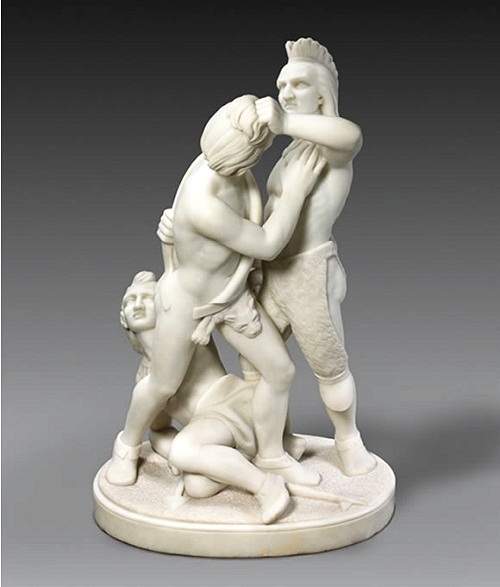 |
| Edmonia Lewis, Indian Combat (1868), Marble (Carrara), 76.2 x 48.3 x 36.5 cm. Photo via clevelandart.org |
Neoclassical masterpiece crafted by first non-white sculptor to gain international acclaim
CLEVELAND (November 1, 2011) — An outstanding American neoclassical work by the renowned 19th century sculptor Edmonia Lewis has been acquired by the Cleveland Museum of Art. The multi-figured Indian Combat ranks among the most ambitious of all free-standing American neoclassical sculptures. Born circa 1842 of African American and Native American (Objibwa) descent, Edmonia Lewis holds the distinction of being the first non-white American sculptor to achieve acclaim internationally. Indian Combat had been in the private collection of a Massachusetts family since the 1950s, and remained unknown to the art world until it surfaced late last year. The acquisition enhances the museum’s distinguished American art holdings and demonstrates the museum’s dedication to add works that strengthen its historic commitment to artistic excellence.
“Edmonia Lewis’s Indian Combat is a remarkable discovery. Its acquisition builds on the museum’s commitment to collect works of art that are both seminal to the careers of individual artists and also significant benchmarks in the history of art,” said C. Griffith Mann, the museum’s deputy director and chief curator.
Indian Combat depicts three Native American men engaged in spirited—yet graceful and balletic—combat with each other. Very few examples of neoclassical sculpture feature more than two figures, and virtually no other work exhibits such a complex integration of multiple protagonists. Conceived fully in the round, Indian Combat’s dynamic composition encourages the viewer to circumnavigate the piece in order to discover the details of the action. Having carved the marble herself—without the use of assistants that was the custom at the time—Lewis rendered a wide variety of complex textures, which can be seen in the moccasins, animal hides and loin cloths worn by the figures.
Lewis specialized in Native American themes, which were widely popular in 19th century American art and literature. Her most common subjects were inspired by The Song of Hiawatha, the epic poem by Henry Wadsworth Longfellow, who was her acquaintance. By contrast, Indian Combat seems to be entirely a product of the sculptor’s own imagination.
Mark Cole, PhD, Cleveland Museum of Art associate curator of American painting and sculpture, has studied Edmonia Lewis’s work since the early 1990s. “When I first saw Indian Combat, I recognized it immediately as a masterpiece, and truly Lewis’s tour de force,” he stated. “It’s a defining work by an artist who led such a fascinating and remarkable life.”
Lewis spent the bulk of her career in Rome during the mid-19th century and earned great renown for her marble carvings. She studied at Ohio’s Oberlin College— one of the first institutions of higher learning in the United States to admit women, as well as persons of color—from 1859-1863, and subsequently apprenticed in Boston before relocating to Italy in 1866. Her studio became an important destination for wealthy Americans and Europeans on their Grand Tours, several of whom became patrons. Highly sought-after in the marketplace, Edmonia Lewis’s works are in private and public collections in a number of countries, including the United States, England, Scotland and Germany.
Indian Combat will go on view in November 2011 (date TBD) in gallery 207 of the Cleveland Museum of Art’s 1916 building.
No comments:
Post a Comment